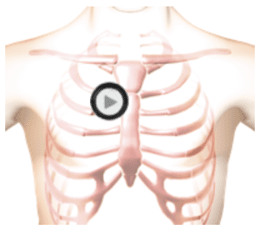Coarctation of the Aorta Auscultation Lesson with Recordings
Virtual Auscultation


The patient's position is sitting leaning forward.
Lesson
This is an example of coarctation of the aorta, a congenital abnormality. This first heart sound is normal. The second heart sound is intensified. There is diamond shaped murmur occupying most of systole and a high-pitched decrescendo murmur in the first half of diastole. In the anatomy video you can see a constriction in the descending aorta which is responsible for the systolic murmur. There is regurgitant flow from the aorta into the left ventricle which causes the diastolic murmur. The left ventricle wall thickness is increased due to aortic pressure elevation caused by the aortic coarctation.Waveform
Heart Sounds Video
Play the cardiac movie and observe a constriction in the descending aorta which is responsible for the systolic murmur.
There is regurgitant flow from the aorta into the left ventricle which causes the diastolic murmur.
The left ventricle wall thickness is increased due to aortic pressure elevation caused by the aortic coarctation.
Authors and Sources
Authors and Reviewers
-
Heart sounds by Dr. Jonathan Keroes, MD and David Lieberman, Developer, Virtual Cardiac Patient.
- Lung sounds by Diane Wrigley, PA
- Respiratory cases: William French
-
David Lieberman, Audio Engineering
-
Heart sounds mentorship by W. Proctor Harvey, MD
- Special thanks for the medical mentorship of Dr. Raymond Murphy
- Reviewed by Dr. Barbara Erickson, PhD, RN, CCRN.
-
Last Update: 12/11/2022
Sources
-
Heart and Lung Sounds Reference Library
Diane S. Wrigley
Publisher: PESI -
Impact Patient Care: Key Physical Assessment Strategies and the Underlying Pathophysiology
Diane S Wrigley & Rosale Lobo - Practical Clinical Skills: Lung Sounds
- Essential Lung Sounds
Diane S. Wrigley, PA-C
Published by MedEdu LLC - PESI Faculty - Diane S Wrigley
-
Case Profiles in Respiratory Care 3rd Ed, 2019
William A.French
Published by Delmar Cengage - Essential Lung Sounds
by William A. French
Published by Cengage Learning, 2011 - Understanding Lung Sounds
Steven Lehrer, MD
- Clinical Heart Disease
W Proctor Harvey, MD
Clinical Heart Disease
Laennec Publishing; 1st edition (January 1, 2009)